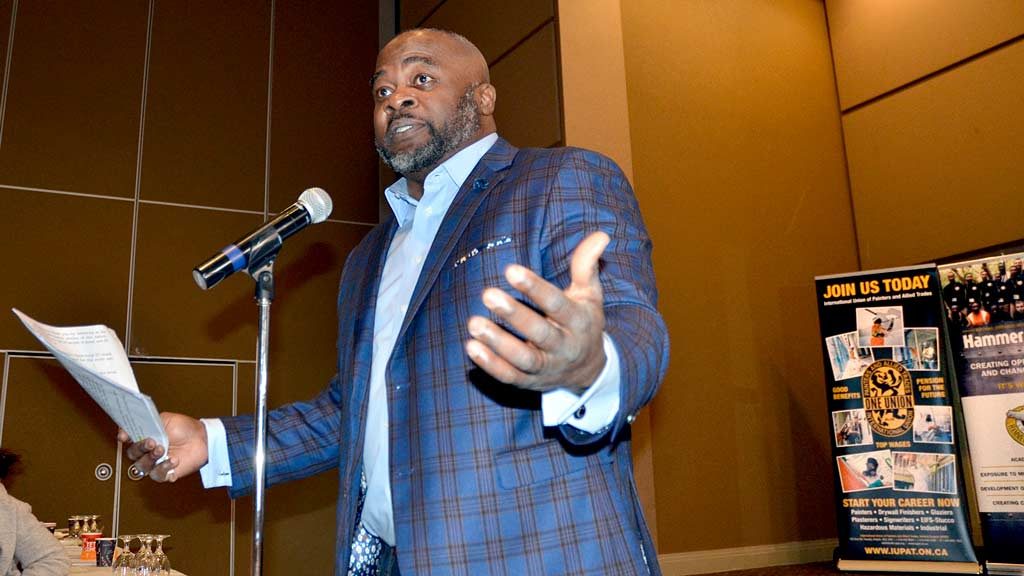The Carpenters’ Union Local 27 held an open house information session recently, bringing trades union representatives together, to share information with community agencies about opportunities for underrepresented groups in construction.
“That’s the idea of you coming here today — to get together, network, share information and meet representatives from different unions that are willing to tell you about their unions and to spread this information, take it back to your community,” explained Chris Campbell, business representative for the Carpenters’ District Council of Ontario.
“Eight trades representatives are here today and about 40 community representatives. It’s a start. This year it’s here, maybe next year it’s at another union. This won’t fix everything but it’s a start for you to build on what we have.”
Paul Daly, vice-president and local union coordinator, Carpenters’ Local 27, said community outreach is key to getting people into the trades.
“We’ve got some industry leaders in this room that are going to tell you what the demands are, the requirements, what it is to go through the apprenticeship programs,” said Daly. “We look at it as this is a community as a whole. This is what we needed to do a long time ago is bring everybody under the same roof and say, ‘what can we do collectively to make this work’ rather than individuals working out there trying to get success in their own group and in their own community.”
Steve Martin, business manager, International Brotherhood of Electrical Workers (IBEW) Local 353 recalls a time when trades reps went to high schools to talk to students about the trades.
“We have failed as a community to keep this type of work open in our school system,” said Martin. “You look now and the average age coming in is around 27. That’s usually a second career… That’s not what we need. We need people to know now that they want to come in. We have great jobs, great benefits, great futures.”
There is an awareness issue that I think we need to address,
— Robert Bronk
Ontario Construction Secretariat
Quoc Truong, business representative, Central Ontario Building Trades (COBT) 25 different construction unions talked about the Hammer Heads program, a skills development program that introduces youth to several different construction trades. Truong, a refugee from Vietnam, got a steamfitter license and is now upper management.
“It changed my life and it changes a lot of lives in our communities,” he said. “When we talk about jobs and careers, youth that go to our program they get all sorts of life experiences. For me, it was to be able to gain confidence and having that network.”
Robert Bronk, CEO, Ontario Construction Secretariat, talked about the looming skilled labour shortage.
“This 100,000-worker deficit — is it a challenge or an opportunity,” asked Bronk. “I would suggest it’s an opportunity. Community benefits agreements is an amazing solution to this opportunity. It’s a win to society and communities, it increases the middle class…it’s a major win for the workers who enter into construction.”
He pointed out there are over 24 trades that people can enter into but most people are only aware of a few.
“There is an awareness issue that I think we need to address,” said Bronk. “These programs have been around for years — Hammer Heads, Helmets to Hardhats, Creating Real Apprenticeships for Toronto (CRAFT)…and they are working, employers have seen the benefits of these programs but we need to scale it up big time.”
Tony Tubbs, representing LiUNA Local 183, said there are also other issues that need to be dealt with in the industry beyond recruiting and retaining workers.
“We still have bigger obstacles to cross more than what we are hearing today about the trades and careers: race and economic status,” Tubbs said. “We need to have a conversation on racism and classes because that is affecting our community right now.”
During the question and answer portion of the event, comments were made referring to the industry as “tribal.”
“It is evident this morning that there can be tribal differences but people are willing to put that aside to make a difference in the community,” Campbell stated, adding when he was organizing the event, he approached the different unions asking them to put their differences aside for the greater good.
“When I explained to them that it’s not about the different unions that have a problem with each other, it’s about reaching folks in the community that want a career, it’s about reaching out to at-risk youth and when I explained that to the union leaders and the business representatives, they took time out of their schedule or they sent a representative.”
Other representatives who spoke at the event include Sean Blake, Carpenters’ Union Local 27; Trevor Cooper, Brick and Allied Craft Union of Canada/Local 2; Ivan Dawn, Painters Union Local 46; and Tom Smith, Interior Finishing System Training Centre/Local 675. Adam Melnick, International Association of Heat and Frost Insulators and Allied Workers/Local 95, was also in attendance.











Unions have offered better education and guidance for years.
The IBEW is an excellent model of providing their own in-house training, why would anyone accept second class education and apprenticeships from other employers. There are trades schools that offer four months of in-house education for an average of $8,000 or more while promoting employment opportunities galore, keep in mind that the hours served in such a school are not ministry approved and that the hours in the school are not acknowledged for apprenticeship.. You can’t buy a C of Q ……. yet!